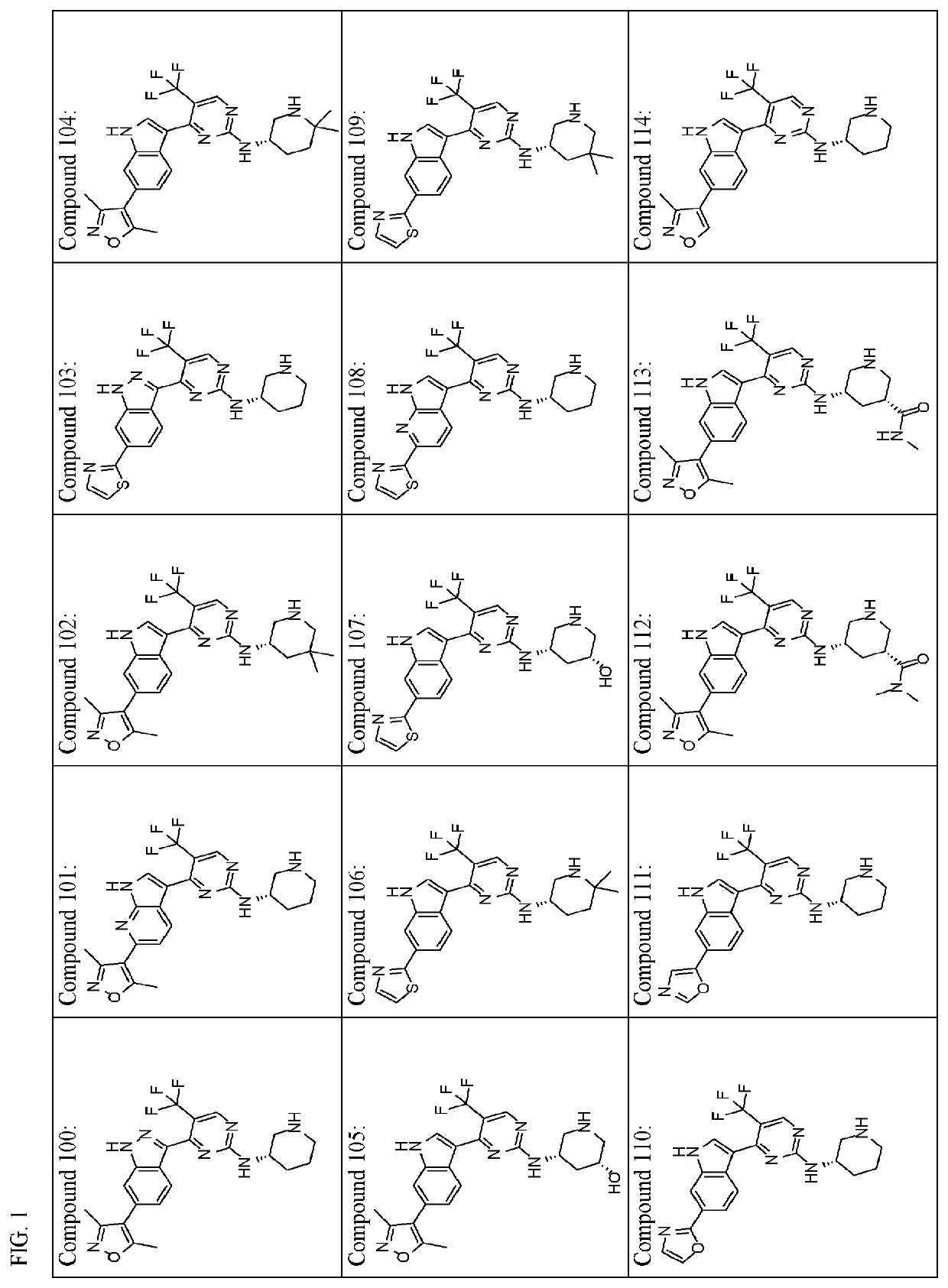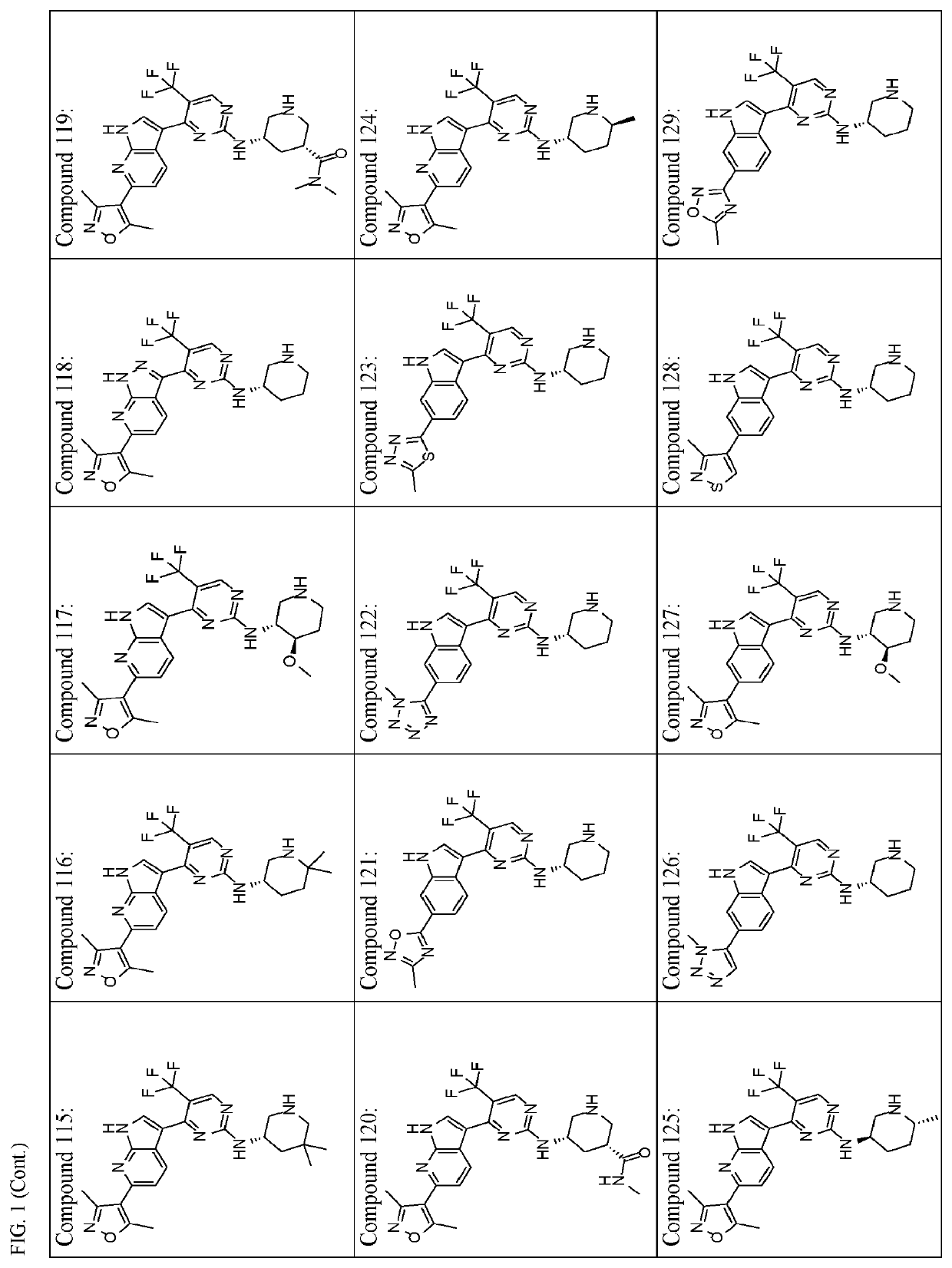Inhibitors of cyclin dependent kinase 7 (CDK7)
a cyclin dependent kinase and inhibitor technology, applied in the field of inhibitors of cyclin dependent kinase 7 (cdk7), can solve the problems of difficult development of selective inhibitors of cdk7, and achieve the effect of improving chemical reactivity and biological activity
- Summary
- Abstract
- Description
- Claims
- Application Information
AI Technical Summary
Benefits of technology
Problems solved by technology
Method used
Image
Examples
example 1
of (S)-4-(6-(3,5-dimethylisoxazol-4-yl)-1H-indol-3-yl)-N-(6,6-dimethylpiperidin-3-yl)-5-(trifluoromethyl)pyrimidin-2-amine (Compound 104)
Step 1: 6-bromo-3-(2-chloro-5-(trifluoromethyl)pyrimidin-4-yl)-1H-indole
[0119]
[0120]To a solution of 2,4-dichloro-5-(trifluoromethyl)pyrimidine (4.87 g, 22.44 mmol) in dichloroethane (29 mL) was added aluminum trichloride (3.26 g, 24.49 mmol). The resulting suspension was stirred at 70° C. for 15 min to provide a clear yellow solution. Reaction mixture was then slightly cooled down (to 60° C.) followed by addition of 6-bromoindole (4.0 g, 20.40 mmol). The resulting orange solution was stirred at 80° C. for 2 h. The reaction mixture was cooled down to RT (room temperature), and ice-cold water was then added followed by stirring for 30 min. The resulting slurry was further diluted with EtOAc (ethyl acetate) and water, then filtered. Aqueous layer was extracted with EtOAc (twice), the organics were combined, dried over Na2SO4, and concentrated under v...
example 2
of (S)—N-(6,6-dimethylpiperidin-3-yl)-4-(6-(thiazol-2-yl)-1H-indol-3-yl)-5-(trifluoromethyl)pyrimidin-2-amine (Compound 106)
Step 1: (S)—N-(6,6-dimethylpiperidin-3-yl)-4-(1-(phenylsulfonyl)-6-(thiazol-2-yl)-1H-indol-3-yl)-5-(trifluoromethyl)pyrimidin-2-amine
[0131]
[0132]To a solution of (S)-4-(6-bromo-1-(phenylsulfonyl)-1H-indol-3-yl)-N-(6,6-dimethylpiperidin-3-yl)-5-(trifluoromethyl)pyrimidin-2-amine (Example 1; 220 mg, 0.36 mmol) in toluene (3.6 mL) was added 2-(tributylstannyl)thiazole (169 mg, 0.45 mmol), and this suspension was degassed for 20 min. Bis(triphenylphosphine)palladium(II) dichloride (13 mg, 0.02 mmol) was then added, and the reaction mixture was stirred at 100° C. for 2 h. After cooling down to RT, the mixture was filtered through Celite, then diluted with water (20 mL) and EtOAc (30 mL) and basified with sat. (saturated) aq. NaHCO3 (5 mL). Organic phase was separated, washed with water (20 mL) and brine (2×10 mL), dried over MgSO4, filtered, and concentrated under r...
example 3
of (S)-4-(6-(oxazol-2-yl)-1H-indol-3-yl)-N-(piperidin-3-yl)-5-(trifluoromethyl)pyrimidin-2-amine (Compound 110) and (S)-4-(6-(oxazol-5-yl)-1H-indol-3-yl)-N-(piperidin-3-yl)-5-(trifluoromethyl)pyrimidin-2-amine (Compound 111)
Step 1: (5)-tert-butyl 3-((4-(6-bromo-1-(phenylsulfonyl)-1H-indol-3-yl)-5-(trifluoromethyl)pyrimidin-2-yl)amino)piperidine-1-carboxylate
[0135]
[0136]A mixture of 1-(benzenesulfonyl)-6-bromo-3-[2-chloro-5-(trifluoromethyl)pyrimidin-4-yl]indole (Example 1, step 2; 1.00 g, 1.94 mmol, 1.00 eq), (S)-tert-butyl (3S)-3-aminopiperidine-1-carboxylate (388.54 mg, 1.94 mmol, 1.00 eq) and DIEA (N,N-diisopropylethylamine; 752.18 mg, 5.82 mmol, 1.02 mL, 3.00 eq) in NMP (N-methyl-2-pyrrolidone; 10.00 mL) was stirred at 140° C. for 1 hr. The mixture was diluted with water (100 mL) and extracted with EtOAc (50 mL×2). Combined organic layers were washed with brine (100 mL×2), dried over Na2SO4, filtered, and concentrated under reduced pressure to a yellow oil. The residue was purif...
PUM
 Login to View More
Login to View More Abstract
Description
Claims
Application Information
 Login to View More
Login to View More - R&D
- Intellectual Property
- Life Sciences
- Materials
- Tech Scout
- Unparalleled Data Quality
- Higher Quality Content
- 60% Fewer Hallucinations
Browse by: Latest US Patents, China's latest patents, Technical Efficacy Thesaurus, Application Domain, Technology Topic, Popular Technical Reports.
© 2025 PatSnap. All rights reserved.Legal|Privacy policy|Modern Slavery Act Transparency Statement|Sitemap|About US| Contact US: help@patsnap.com



